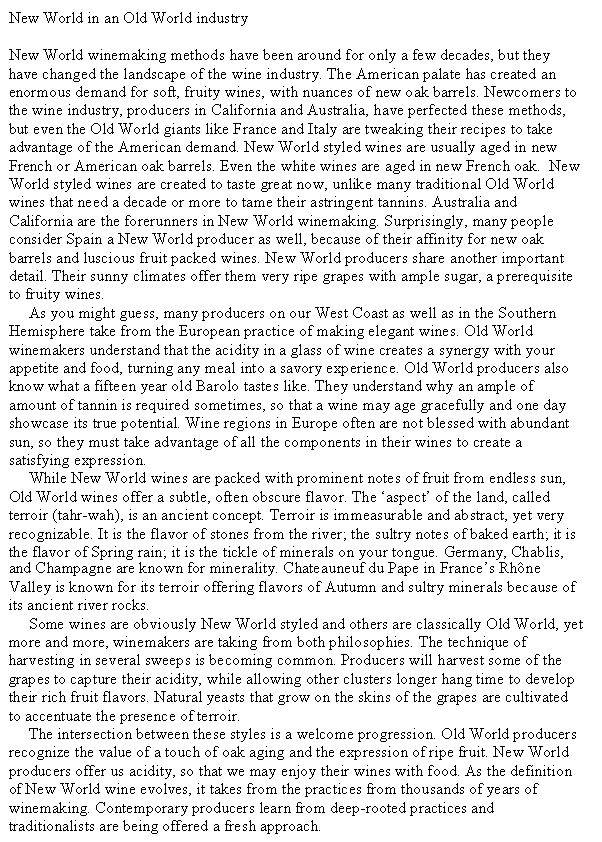




Articles are property of Brenda Francis and are not to be reproduced in any way without written consent from Brenda Francis. New World in an Old World industry New World winemaking methods have been around for only a few decades, but they have changed the landscape of the wine industry. The American palate has created an enormous demand for soft, fruity wines, with nuances of new oak barrels. Newcomers to the wine industry, producers in California and Australia, have perfected these methods, but even the Old World giants like France and Italy are tweaking their recipes to take advantage of the American demand. New World styled wines are usually aged in new French or American oak barrels. Even the white wines are aged in new French oak. New World styled wines are created to taste great now, unlike many traditional Old World wines that need a decade or more to tame their astringent tannins. Australia and California are the forerunners in New World winemaking. Surprisingly, many people consider Spain a New World producer as well, because of their affinity for new oak barrels and luscious fruit packed wines. New World producers share another important detail. Their sunny climates offer them very ripe grapes with ample sugar, a prerequisite to fruity wines. As you might guess, many producers on our West Coast as well as in the Southern Hemisphere take from the European practice of making elegant wines. Old World winemakers understand that the acidity in a glass of wine creates a synergy with your appetite and food, turning any meal into a savory experience. Old World producers also know what a fifteen year old Barolo tastes like. They understand why an ample of amount of tannin is required sometimes, so that a wine may age gracefully and one day showcase its true potential. Wine regions in Europe often are not blessed with abundant sun, so they must take advantage of all the components in their wines to create a satisfying expression. While New World wines are packed with prominent notes of fruit from endless sun, Old World wines offer a subtle, often obscure flavor. The 'aspect' of the land, called terroir (tahr-wah), is an ancient concept. Terroir is immeasurable and abstract, yet very recognizable. It is the flavor of stones from the river; the sultry notes of baked earth; it is the flavor of Spring rain; it is the tickle of minerals on your tongue. Germany, Chablis, and Champagne are known for minerality. Chateauneuf du Pape in France's Rhône Valley is known for its terroir offering flavors of Autumn and sultry minerals because of its ancient river rocks. Some wines are obviously New World styled and others are classically Old World, yet more and more, winemakers are taking from both philosophies. The technique of harvesting in several sweeps is becoming common. Producers will harvest some of the grapes to capture their acidity, while allowing other clusters longer hang time to develop their rich fruit flavors. Natural yeasts that grow on the skins of the grapes are cultivated to accentuate the presence of terroir. The intersection between these styles is a welcome progression. Old World producers recognize the value of a touch of oak aging and the expression of ripe fruit. New World producers offer us acidity, so that we may enjoy their wines with food. As the definition of New World wine evolves, it takes from the practices from thousands of years of winemaking. Contemporary producers learn from deep-rooted practices and traditionalists are being offered a fresh approach.